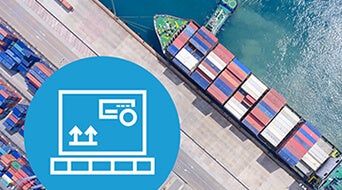One Year Wiser – 2020 Learnings For Smarter Ltl Shipping In 2021
Between COVID-19, a surge in e-commerce and soaring demand creating carrier bottlenecks, everyone had to manage tough shipping logistics in 2020. While it would be great to have a clean slate in 2021, much of what led us here drives next year's challenges.
Thankfully, you'll be one year wiser. It's a perfect time for small and mid-size businesses (SMBs) to reflect and build a plan that turns this year's lumps into insights or even advantages. We know that the holiday rush will keep most SMBs busy. But, we want you to leap into 2021 with fresh ideas. To help you prepare, we put together less than truckload (LTL) trends and tips for a faster start to next year.
Shipping carriers changing the game
The first thing to know is that carrier capacity will continue to be a challenge that defines the velocity of materials and overall supply chain costs. The shifts in freight volume, as well as unpredictable market closures and reopenings due to COVID-19, created a resource-allocation nightmare for shipping companies in 2020. Now with shipping demand at all-time highs as the economy recovers, carriers cannot keep up. Unfortunately, it's hard for them to scale – attracting more drivers was a challenge before 2020, and the typical hub-and-spoke distribution model makes pivoting difficult. So shippers need to work with the resources available.
The economic recovery, holiday shopping and the overseas restocking due to hit carriers over the next few months all combine for tighter carrier capacity for the foreseeable future. We're already experiencing the repercussions of stuffed trucks, such as:
- Increases to freight rates
- Delivery delays,
These are unfortunate norms, but transportation companies may bring other changes if volume doesn't drop. For example, they may limit their shipper and freight broker partnerships to simplify routes and freight management. In this scenario, SMB shippers with low volume or shallow budgets will need to figure out how to capture carriers' attention. This could mean changing how they work with carriers or partnering with a third-party logistics company (3PL) to punch above their weight. It's an extreme scenario, but shippers should have a plan for the many potential (and unpredictable) outcomes of capacity crunch going deep into 2021.
Keys to LTL Freight in 2021
How can shippers prepare their LTL freight operations for these changes? When building a plan, it's important to remember that uncertainty surrounds the transportation industry – the pandemic, presidential election and freight volume can change shipping rates, truck availability and the economic climate. But shippers shouldn't sit back and wait. It's critical to prepare for a variety of scenarios. System and process flexibility will keep shipments moving consistently despite factors outside your business adding complexity. Here are a few strategies to consider when preparing for 2021:
- Don't play favorites. It's easy to rely on one or two carriers for all your freight. But the reduced phone calls and emails also come with limited booking availability and minimal flexibility. Even if you continue working with a few favorites, casting a wider net helps book shipments that fit your delivery dates and budget. It's important to find a balance between volume-based discounts and carrier availability. However, this may increase logistics complexity, so it might make sense to bring in a 3PL that can help scale your operations.
- Consider a partner. According to a recent study1, 72% of businesses found that 3PLs helped reduce overall logistics costs, while 73% find these partners bring new, innovative ways to improve logistics. Adding a 3PL offers three benefits:
- Aggregate quotes from a wide carrier network
- Holistic solutions for parcel, full truckload and LTL freight
- Value-add or managed services to help shippers with booking, claims, shipment tracking and time-saving efficiencies.
- New challenges, new tools. If SMBs leverage e-commerce systems to please customers and a customer relationship management system (CRM) to enable sales, why would they rely on email and spreadsheets for complex shipping logistics? Shipping systems such as a transportation management system (TMS) brings tangible, bottom-line value to the table. Nearly 50% of businesses save anywhere from 5-10% on their freight costs with the help of a TMS.2 These systems can plug directly into existing software, including home-grown solutions. A TMS brings:
- Time-saving resources when booking trucks
- Simplified shipment tracking
- Billing consolidation
- Scalability
But if you can't afford or don't want to go through the technological hassle of installing one yourself, this is where a 3PL comes in handy. Many have their own online TMS platforms, like SpeedShip® from Worldwide Express, which give you all the convenience with none of the required upkeep or extra cost.
These strategies help build flexible, resilient transportation ecosystems. But, there's no silver bullet. Every business requires different solutions. Yes, it is more work to manage multiple carriers or to bring on new systems. But, it's clear that many SMBs will need to strengthen their shipping operations to keep boxes moving.
Add a 3PL and make shipping your differentiator, not deficiency
It will be difficult to continue doing the same thing and expect different results. Big challenges require big thinking and innovation. Shipping logistics isn't as flashy as launching new products or a big marketing campaign, but it will be a differentiator in SMB shipping nonetheless.
So ask yourself: What is LTL freight looking like for me next year? As a 3PL dedicated to SMBs, we're helping thousands of businesses get ready for next year. Let's build a plan to futureproof your shipping operations.
1 "2019 23rd Annual Third-Party Logistics Study: The State of Logistics Outsourcing"
C. John Langley Jr., Ph.D., and Infosys, 2019
2 Transportation Management Systems, ARC Advisory Group
